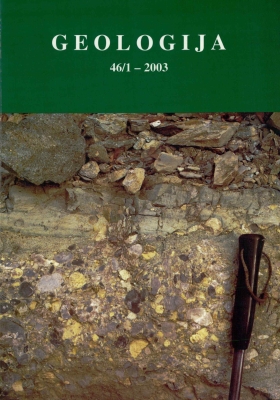Chemical composition of cave sediment in Potočka zijalka, Mt. Olševa, North Slovenia
DOI:
https://doi.org/10.5474/geologija.2003.012Abstract
Potočka zijalka was a station of Aurignatien hunters and the site of rich fossil remains of Pleistocene large mammals. Clastic sediments were deposited in Würm and are an intimate mixture of gravel, sand, silt and clay occurring in various proportions. The fractions form distinct populations, which were transported by different agents, like rockfall, flowing water, ephemeral torrent flows and cryoturbation. The sediment constituents are petrologically rather diverse and indicate that they were derived from different parent rocks - Mesozoic limestone, Permian-Carboniferous shales, Tertiary fine-grained sediments and fluvial pebbly deposits. Bulk chemical composition is strongly influenced by the limestone component, but the majority of trace elements, like Ti, Li, V, Fe, Co, Zn, Ga, Y, REE, Zr, Nb, Cs, Hf and Th originates from clay and fine silt, and Mn, Pb, Ni, Cu and Sn mainly from the heavz minerals in the sand fraction. Ca, Mg, Br, Rb, Sr and U show strong correlation with the amount of carbonate component. Rare earth elements, normalised to PAAS are not appreciable fractionated and show light positive europium anomalies.Downloads
How to Cite
Kralj, P., & Bole, B. (2003). Chemical composition of cave sediment in Potočka zijalka, Mt. Olševa, North Slovenia . Geologija, 46(1), 123–128. https://doi.org/10.5474/geologija.2003.012
Issue
Section
Articles

